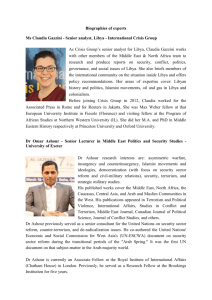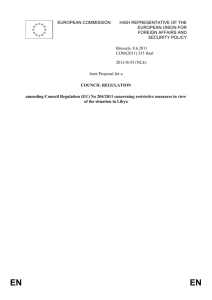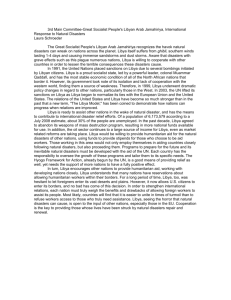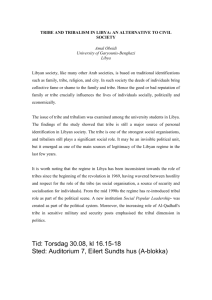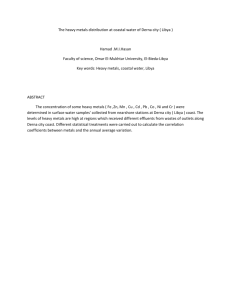Business and Management Review Vol. 1(11) pp. 01 – 07 January
advertisement
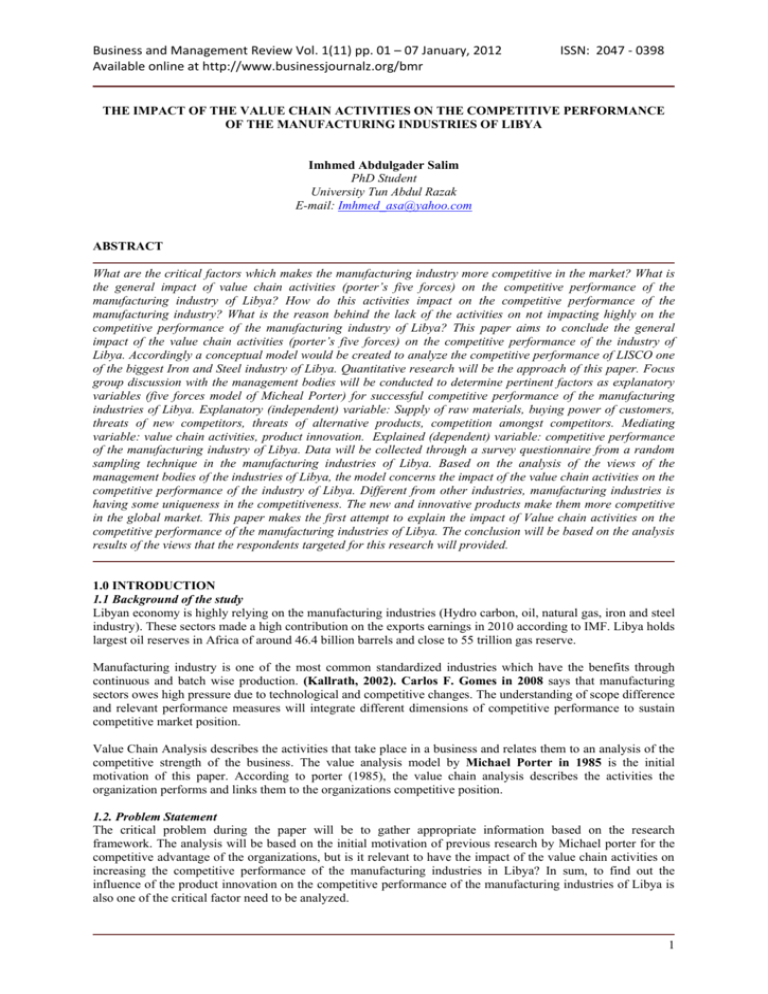
Business and Management Review Vol. 1(11) pp. 01 – 07 January, 2012 Available online at http://www.businessjournalz.org/bmr ISSN: 2047 - 0398 THE IMPACT OF THE VALUE CHAIN ACTIVITIES ON THE COMPETITIVE PERFORMANCE OF THE MANUFACTURING INDUSTRIES OF LIBYA Imhmed Abdulgader Salim PhD Student University Tun Abdul Razak E-mail: Imhmed_asa@yahoo.com ABSTRACT What are the critical factors which makes the manufacturing industry more competitive in the market? What is the general impact of value chain activities (porter’s five forces) on the competitive performance of the manufacturing industry of Libya? How do this activities impact on the competitive performance of the manufacturing industry? What is the reason behind the lack of the activities on not impacting highly on the competitive performance of the manufacturing industry of Libya? This paper aims to conclude the general impact of the value chain activities (porter’s five forces) on the competitive performance of the industry of Libya. Accordingly a conceptual model would be created to analyze the competitive performance of LISCO one of the biggest Iron and Steel industry of Libya. Quantitative research will be the approach of this paper. Focus group discussion with the management bodies will be conducted to determine pertinent factors as explanatory variables (five forces model of Micheal Porter) for successful competitive performance of the manufacturing industries of Libya. Explanatory (independent) variable: Supply of raw materials, buying power of customers, threats of new competitors, threats of alternative products, competition amongst competitors. Mediating variable: value chain activities, product innovation. Explained (dependent) variable: competitive performance of the manufacturing industry of Libya. Data will be collected through a survey questionnaire from a random sampling technique in the manufacturing industries of Libya. Based on the analysis of the views of the management bodies of the industries of Libya, the model concerns the impact of the value chain activities on the competitive performance of the industry of Libya. Different from other industries, manufacturing industries is having some uniqueness in the competitiveness. The new and innovative products make them more competitive in the global market. This paper makes the first attempt to explain the impact of Value chain activities on the competitive performance of the manufacturing industries of Libya. The conclusion will be based on the analysis results of the views that the respondents targeted for this research will provided. 1.0 INTRODUCTION 1.1 Background of the study Libyan economy is highly relying on the manufacturing industries (Hydro carbon, oil, natural gas, iron and steel industry). These sectors made a high contribution on the exports earnings in 2010 according to IMF. Libya holds largest oil reserves in Africa of around 46.4 billion barrels and close to 55 trillion gas reserve. Manufacturing industry is one of the most common standardized industries which have the benefits through continuous and batch wise production. (Kallrath, 2002). Carlos F. Gomes in 2008 says that manufacturing sectors owes high pressure due to technological and competitive changes. The understanding of scope difference and relevant performance measures will integrate different dimensions of competitive performance to sustain competitive market position. Value Chain Analysis describes the activities that take place in a business and relates them to an analysis of the competitive strength of the business. The value analysis model by Michael Porter in 1985 is the initial motivation of this paper. According to porter (1985), the value chain analysis describes the activities the organization performs and links them to the organizations competitive position. 1.2. Problem Statement The critical problem during the paper will be to gather appropriate information based on the research framework. The analysis will be based on the initial motivation of previous research by Michael porter for the competitive advantage of the organizations, but is it relevant to have the impact of the value chain activities on increasing the competitive performance of the manufacturing industries in Libya? In sum, to find out the influence of the product innovation on the competitive performance of the manufacturing industries of Libya is also one of the critical factor need to be analyzed. 1 Business and Management Review Vol. 1(11) pp. 01 – 07 January, 2012 Available online at http://www.businessjournalz.org/bmr ISSN: 2047 - 0398 1.3. Research Questions With the variables effective for the competitive advantage/ performance we have manufactured some of the critical and most important questions which needs to be evaluated. The following acts as a research questions which need to be evaluated: 1) How the consistency in the supply of raw materials can increase the competitive performance of the manufacturing industries of Libya? 2) What impact does the buying power of the customers contribute towards enhancing the competitive performance of the manufacturing industries of Libya? 3) How threat of new competitors will impact on the competitive performance of the manufacturing industries of Libya? 4) What impact does threat of alternative products exerts to have effect on the competitive performance of the manufacturing industries of Libya? 5) What impact does competition amongst competitors do on the competitive performance in the manufacturing industries of Libya? 6) Which factor of the value chain activities impacts heavily on the competitive performance of the manufacturing industries in Libya? 7) How production innovation impacts on the competitive performance of the manufacturing industries in Libya? 1.4. Research objectives With keeping view of the research questions we need to examine the following research objectives of the research: 1) To examine the typology of supply of raw material in affecting the competitive performance of the manufacturing industries in Libya. 2) To evaluate the contribution of the buying power of the customers to affect on the competitive performance of the manufacturing industries in Libya. 3) To investigate on threat of new competitors on influencing the competitive performance of the manufacturing industries in Libya. 4) To examine threat of alternative products in impacting on the competitive performance of the manufacturing industries in Libya. 5) To analyze the role of competition amongst competitors on the competitive performance in the manufacturing industries of Libya. 6) To examine the value chain factors impacting heavily on the competitive performance in the manufacturing industries of Libya. 7) To analyze the impact of production innovation on the competitive performance of the manufacturing industries in Libya. 1.5. Significance of the study The factors of the value chain activities which have impact on the competitive performance of the manufacturing industries in Libya that has been taken in this research as a variables are supply of raw materials, buying power of customers, threats of new competitors, threats of alternative products, competition amongst competitors, product innovations. The main aim of this paper is to identify the critical factors in the manufacturing industries which make them more competitive in the market. 2 Business and Management Review Vol. 1(11) pp. 01 – 07 January, 2012 Available online at http://www.businessjournalz.org/bmr ISSN: 2047 - 0398 The research’s goal is designed to help the managers to improve the competence, develop managerial skills, and to increase the competitive advantage skills on the business entrepreneurs of Libya. This goal can be achieved through the analysis of the factors that is used in this research. 1.6. Outline of the research Chapter one establishes the background of the research, the statement of the problem, the research questions and the research objective that is to be evaluated. Chapter Two provides a review of the relevant literature dealing with the factors having high impact in influencing the competitive performance of the manufacturing industries in Libya, the conceptual development to the model and previous studies based on the research title. Chapter Three provides an overview of the methodology used and the data analysis procedure. 2.0 LITERATURE REVIEW 2.1. Underpinning theory In the manufacturing industries the competitiveness has been increased tremendously due to rapid globalization. The increase in the competitive market not only focuses the industries to enhance their technological skills, but also makes them to understand and study their competitive power to sustain in the global market. Here we deals with value chain activities proposed by the theory of competitive strategy originated by Michael porter in 1985. The competitiveness of the industry can be evaluated by the theory of competitive strategy arguing that there are some contextual factors in the industries which exerts the competitive performance in Libya. This research is an extended research taken from the idea of Michael porter who managed to analyze the competitiveness of the industry. By following this research there has been some of the personal contribution in this research. As per the review of the literature based on the competitive performance evaluation product innovation was also included as a critical factor to impact on the competitiveness. Organizational competitiveness is the consequences of the decisions made by its leaders. The framework that guides and focuses these decisions is strategy. 2.2. Value chain activities Value chain analysis describes the activities within and around an organization, and relates them to an analysis of the competitive strength of the organization. Therefore, it evaluates which value each particular activity adds to the organizations products or services. What activities an organization undertakes is directly linked to achieving competitive advantage. For example, a business which wishes to outperform its competitors through production innovation itself through higher quality will have to perform its value chain activities better than the opposition. Supply of raw materials Different supplier provides different inputs characteristics in performing the same job. The greater the degrees of differentiation among suppliers the more bargaining power suppliers have. Presence and availability of substitute means the extent to which it is possible to switch to another supplier for an input or a close substitute. The greater the number and closeness of substitute inputs the lower the bargaining power of suppliers. Supplier bargaining power is likely to be high when: The market is dominated by a few large suppliers rather than a fragmented source of supply, There are no substitutes for the particular input, The supplier’s customers are fragmented, so their bargaining power is low, The switching costs from one supplier to another are high, There is the possibility of the supplier integrating forwards in order to obtain higher prices and margins. This threat is especially high when: The buying industry has a higher profitability than the supplying industry, Forward integration provides economies of scale for the supplier, The buying industry hinders the supplying industry in their development The buying industry has low barriers to entry. In such situations, the buying industry often faces a high pressure on margins from their suppliers. The relationship to powerful suppliers can potentially reduce strategic options for the organization. Usually the more concentrated the industry, the fewer suppliers and the more control suppliers have over the prices they charge. Greater supplier concentration often means greater supplier bargaining power. Supplier 3 Business and Management Review Vol. 1(11) pp. 01 – 07 January, 2012 Available online at http://www.businessjournalz.org/bmr ISSN: 2047 - 0398 concentration is the degree of competition among suppliers Cost relative to total purchases in the industry refers to the amount your industry spends on inputs from a particular supplier compared to the total revenue of all firms in the supplier’s industry. Lower expenditure usually implies more bargaining power for the supplier. The buyer’s bargaining power falls as spending with a particular firm falls simply because the buyer’s business isn’t as important to the supplier. The model of five forces is based on the idea of competition. It assumes that companies try to achieve competitive advantages over other players in the markets as well as over suppliers or customers. 2.3. Buying power of the customers Customers bargaining power is likely to be high when they buy in large volumes, when there is a concentration of buyers, when the supplying industry comprises a large number of small operators, the supplying industry operates with high fixed costs, the product is undifferentiated and can be replaces by substitutes. Switching to an alternative product is relatively simple and is not related to high costs, Customers have low margins and are price-sensitive, Customers could produce the product themselves, the product is not of strategically importance for the customer, the customer knows about the production costs of the product there is the possibility for the customer integrating backwards. (Dagmar Recklies, 2001) http://www.themanager.org/models/p5f.htm.To reduce the bargaining power of the customers, the industries of Libya needs to make some changes in their competitive strategic system by partnering, supply chain management, increasing incentives and value added; moving purchase decision away from price, go directly to customers. 2.4. Threats of new competitors: The competition in an industry will be the higher, the easier it is for other companies to enter this industry. In such a situation, new entrants could change major determinants of the market environment (e.g. market shares, prices, customer loyalty) at any time. There is always a latent pressure for reaction and adjustment for existing players in this industry. The threat of new entries will depend on the extent to which there are barriers to entry. The following steps can eventually decrease the threats of new competitors in the market. Minimizing size requirements for profit operations Brand loyalty of customers Protected intellectual property like patents, licenses etc, Scarcity of important resources, e.g. qualified expert staff Access to raw materials is controlled by existing players, Distribution channels are controlled by existing players, Existing players have close customer relations, e.g. from long-term service contracts, High switching costs for customers Legislation and government action Different sector of industry have different threats of new entrants. Some companies have unique products which makes them monopolistic in the market with less new entrants. E.g. Oil companies, whereas the consumer industries have very high threats of new entrants in the market. Barriers to entry in the local oil market are high due to capital investments, licensing, and knowledge requirements. However, having competition close to a business does not necessarily have a negative effect on the bottom line. Therefore, some industries may actually encourage and support new entrants up to a point. (Sally Linton, Department of Food Science, Purdue Extension) 2.5. Threats of alternative products A threat from alternative products exists if there are alternative products with lower prices of better performance parameters for the same purpose. They could potentially attract a significant proportion of market volume and hence reduce the potential sales volume for existing players. This category also relates to complementary products. Substitutes are a greater threat when: The product doesn’t offer any real benefit compared to other products. What will hold the customers if they can get an identical product from the competitor? It is easy for customers to switch. A grocer can easily switch from paper to plastic bags for its customers, but a bottler may have to reconfigure its equipment and retrain its workers if it switches from aluminum cans to plastic bottles. 4 Business and Management Review Vol. 1(11) pp. 01 – 07 January, 2012 Available online at http://www.businessjournalz.org/bmr ISSN: 2047 - 0398 Customers have little loyalty. When price is the customer’s primary motivator, the threat of substitutes is greater. The threat of substitute’s products can be reduced by using tactics such as staying closely in tune with customer preferences and differentiating your product by branding. In some cases, the advertising required to differentiate is more than one firm can bear. In that case, collective advertising for an industry may be more effective. Some other actions like legal action, increasing switching costs, customer survey to learn about preferences can also reduce the threats of alternative products. 2.6. Competition amongst competitors Competition is the foundation of the free enterprise system, yet with small businesses even a little competition goes a long way. Because companies in an industry are mutually dependent, actions by one company usually invite competitive retaliation. An analysis of rivalry looks at the extent to which the value created in an industry will be dissipated through head-to-head competition. Rivalry among competitors is often the strongest of the five competitive forces, but can vary widely among industries. If the competitive force is weak, companies may be able to raise prices, provide fewer products for the price, and earn more profits. If competition is intense, it may be necessary to enhance product offerings to keep customers, and prices may fall below break-even levels. This force describes the intensity of competition between existing players (companies) in an industry. High competitive pressure results in pressure on prices, margins, and hence, on profitability for every single company in the industry. The competition amongst competitors arises when they possess similar products in the market. Customers can easily switch between products. To reduce the competition amongst competitors: Avoid price competition Differentiate your product Buy out competition Reduce industry over-capacity Focus on different segments Communicate with competitors Product innovation An industry can be in a secured position related to competitive if it is having an innovated product (Ven, 1986). Nord and Tucker (1987) identified the routine innovation and radical innovation in product development. Accordingly, routine innovation means the introduction of something to organization that is similar to previous ones, while radical innovation means introducing something that is unprecedented to organization. Porter (1985) considers innovation as a critical competitive advantage to success. Similarly, the impact of innovation on firm’s overall performance is demonstrated by a substantial body of literatures. Innovation is the multi-stage process whereby organizations transform ideas into improved products, service or processes, in order to advance, compete and differentiate themselves successfully in their marketplace. Baregheh et al. (2009) 3.0 RESEARCH METHODOLOGY 3.1. Research design: The current research will adopt the theory of competitive strategy to illustrate the competitive performance of the manufacturing industries in Libya. Competitive performance grows the value of the industries and is able to create for its buyers that exceed the company’s cost of creating it. Value is what buyers are willing to pay, and superior value stems from offering lower prices than competitors for equivalent benefits or providing unique benefits that more than offset a higher price. The Competitive Advantage theory suggests that everyone is better off if decisions are made based on the competitive advantage at all levels. Simply stated, it is nothing more than asking for optimal utilization of resources and the globalization of manufacturing and services across the world as if we lived in a borderless world. 5 Business and Management Review Vol. 1(11) pp. 01 – 07 January, 2012 Available online at http://www.businessjournalz.org/bmr ISSN: 2047 - 0398 Research design consists of research methodology, methods, as well as data collection and analysis techniques depending on the aims and objectives of the research. .Research designs are concerned with turning the research questions into a testing project. The best design depends on the research questions. Every design has its positive and negative sides. However, there are two typical research designs that can be constructed by researchers, these are; qualitative research and quantitative research. For the purpose of this research, the researcher is going to analyze his study using quantitative research design. The main objective of the research is to identify the impact of value chain activities on the competitive performance of the manufacturing industries in Libya. This objective explains a descriptive relationship that clarifies features. This research is descriptive in survey. This research is descriptive as it is explaining the existing situation and it is surveying because of the statistical source is the questionnaire that will be taken in the consideration. The technical use of Statistical package of social sciences (SPSS) and the Structural equation model (SEM) will be used to analyze the data and for the data analysis procedures. The main advantage of Structural equation model is we can know the validity of the model including the validity of the latent variable and the observed variables. The second advantage of the SEM is to reduce the measurement error which makes the observed variables unbiased. 3.2. Research framework: supply of raw materials buying power of customers product innovation competitive performance value chain activities competition amongst competitors threats of new competitors threats of alternative products Structure of this paper, own design, Source Michael Porter, 1985, Linnan Yu, 2011 3.3. Research hypothesis From the research model and a literature review undertaken to identify the contextual managerial factors to evaluate the value chain activities in the organization, the following hypothesis were formulated: H1: There is a positive relationship between the supply of raw materials and the competitive performance in the manufacturing industries of Libya. H2: There is a positive relationship between the buying power of customers and competitive performance in the manufacturing industries of Libya. H3: There is a positive relationship between the threats of new competitors and the competitive performance in the manufacturing industries of Libya. H4: There is a positive relationship between the threats of alternative products and the competitive performance in the manufacturing industries of Libya. 6 Business and Management Review Vol. 1(11) pp. 01 – 07 January, 2012 Available online at http://www.businessjournalz.org/bmr ISSN: 2047 - 0398 H5: There is a positive effect of competition amongst competitors and the competitive performance in the manufacturing industries of Libya. H6: There is a positive influence of product innovation and the competitive performance in the manufacturing industries of Libya. 3.4. Population and sample As far as doing every scholarly research concerns with time and cost, the possibility of total exploration of community based on statistics is most of the time impossible. Thus, the sample choice and sampling method is indispensable for the research. The sampling method in this research is an accidental simple kind and numbers of statistical sample has designated by the purposive sampling technique. The total population will be estimated which will give the idea to analyze the total samples for the research. Purposive sampling targets a particular group of people. When the desired population for the study is rare or very difficult to locate and recruit for a study, purposive sampling may be the only option to use. 3.5. Data collection technique Data collection is a term used to describe a process of preparing and collecting data. A survey has two broad categories of data collection techniques, questionnaires and interviews (Trochim, 2006; Leedy and Ormrod, 2005). This study will make use of the questionnaire method of data collection. A questionnaire is a list of carefully structured questions, chosen after considerable testing, with a view to eliciting reliable responses from a chosen sample (Collis and Hussey, 2003). Data for this research will be collected from the manufacturing organizations across Libya. Data will be collected on the range of manufacturing companies, within some selected industries of Libya. Since this data will be collected on the basis of the survey questionnaire it will be considered as a secondary data source. REFERENCES Baregheh, A., Rowley, J. and Sambrool, S. (2009), Towards a multidisciplinary definition of innovation. Management Decision, Vol. 47, No. 8, PP. 1323-1339. Dagmar Recklies, June 2001, retrieved from http://www.themanager.org/models/p5f.htm Carlos F Gomes, C.F.Y., Mahmoud, M. and Lisboa, J.V. (2008), “Project management in the context of organizational change: the case of the Portuguese public sector”, International Journal of Public Sector Management, Vol. 21 No. 6, pp. 573-85. Dagmar Recklies, June 2001, retrieved from http://www.themanager.org/models/P5F_2.htm Dagmar Recklies, 2001, Recklies Management Project GmbH § www.themanager.org Linnan Yu, 2011, Impact of Critical Value Chain Activities on Product Performance in Process Industry, University of Gavle, hig.diva-portal.org/smash/get/diva2:423642/FULLTEXT01 Kallrath, J. (2002). Planning and scheduling in the process industry. OR Spectrum, Vol. 24, No.3, PP. 219-250. Sally Linton, Department of Food Science, Industry Analysis: The Five Forces Purdue Extension, Nord, W. R., & Tucker, S. (1987). Implementing routine and radical innovations. San Francisco: New Lexington Press. Porter, M.E. (1985), Competitive strategy: Creating and sustaining superior performance, New York, NY. Van de Ven, A.H. (1986) Central problems in the management of innovation. Management Science, Vol. 32, No. 5, pp. 590-607. Trochim W.M.K., (2006). ‘Research Methods Knowledge Base’.Online accessed 29th November, 2010. Available from URL: http://www.socialresearchmethods.net/kb/scallik.php 7


